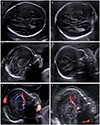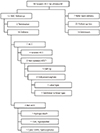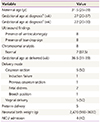1. Paul LK, Brown WS, Adolphs R, Tyszka JM, Richards LJ, Mukherjee P, et al. Agenesis of the corpus callosum: genetic, developmental and functional aspects of connectivity. Nat Rev Neurosci. 2007; 8:287–299.
2. Engels AC, Joyeux L, Brantner C, De Keersmaecker B, De Catte L, Baud D, et al. Sonographic detection of central nervous system defects in the first trimester of pregnancy. Prenat Diagn. 2016; 36:266–273.
3. Grogono JL. Children with agenesis of the corpus callosum. Dev Med Child Neurol. 1968; 10:613–616.
4. d'Ercole C, Girard N, Cravello L, Boubli L, Potier A, Raybaud C, et al. Prenatal diagnosis of fetal corpus callosum agenesis by ultrasonography and magnetic resonance imaging. Prenat Diagn. 1998; 18:247–253.
5. Jeret JS, Serur D, Wisniewski K, Fisch C. Frequency of agenesis of the corpus callosum in the developmentally disabled population as determined by computerized tomography. Pediatr Neurosci. 1985-1986; 12:101–103.
6. Pilu G, Sandri F, Perolo A, Pittalis MC, Grisolia G, Cocchi G, et al. Sonography of fetal agenesis of the corpus callosum: a survey of 35 cases. Ultrasound Obstet Gynecol. 1993; 3:318–329.
7. Volpe P, Paladini D, Resta M, Stanziano A, Salvatore M, Quarantelli M, et al. Characteristics, associations and outcome of partial agenesis of the corpus callosum in the fetus. Ultrasound Obstet Gynecol. 2006; 27:509–516.
8. Moutard ML, Kieffer V, Feingold J, Lewin F, Baron JM, Adamsbaum C, et al. Isolated corpus callosum agenesis: a ten-year follow-up after prenatal diagnosis (how are the children without corpus callosum at 10 years of age?). Prenat Diagn. 2012; 32:277–283.
9. Hetts SW, Sherr EH, Chao S, Gobuty S, Barkovich AJ. Anomalies of the corpus callosum: an MR analysis of the phenotypic spectrum of associated malformations. AJR Am J Roentgenol. 2006; 187:1343–1348.
10. Tang PH, Bartha AI, Norton ME, Barkovich AJ, Sherr EH, Glenn OA. Agenesis of the corpus callosum: an MR imaging analysis of associated abnormalities in the fetus. AJNR Am J Neuroradiol. 2009; 30:257–263.
11. Comstock CH, Culp D, Gonzalez J, Boal DB. Agenesis of the corpus callosum in the fetus: its evolution and significance. J Ultrasound Med. 1985; 4:613–616.
12. Shevell MI. Clinical and diagnostic profile of agenesis of the corpus callosum. J Child Neurol. 2002; 17:896–900.
13. Noguchi R, Abe K, Hamada H, Ogura T, Obata M, Miyazono Y, et al. Outcomes of patients with prenatally diagnosed agenesis of the corpus callosum in conjunction with ventriculomegaly. Arch Gynecol Obstet. 2014; 290:237–242.
14. Gupta JK, Lilford RJ. Assessment and management of fetal agenesis of the corpus callosum. Prenat Diagn. 1995; 15:301–312.
15. Vergani P, Ghidini A, Strobelt N, Locatelli A, Mariani S, Bertalero C, et al. Prognostic indicators in the prenatal diagnosis of agenesis of corpus callosum. Am J Obstet Gynecol. 1994; 170:753–758.
16. Mangione R, Fries N, Godard P, Capron C, Mirlesse V, Lacombe D, et al. Neurodevelopmental outcome following prenatal diagnosis of an isolated anomaly of the corpus callosum. Ultrasound Obstet Gynecol. 2011; 37:290–295.
17. Francesco P, Maria-Edgarda B, Giovanni P, Dandolo G, Giulio B. Prenatal diagnosis of agenesis of corpus callosum: what is the neurodevelopmental outcome? Pediatr Int. 2006; 48:298–304.
18. Li Y, Estroff JA, Khwaja O, Mehta TS, Poussaint TY, Robson CD, et al. Callosal dysgenesis in fetuses with ventriculomegaly: levels of agreement between imaging modalities and postnatal outcome. Ultrasound Obstet Gynecol. 2012; 40:522–529.
19. Al-Hashim AH, Blaser S, Raybaud C, MacGregor D. Corpus callosum abnormalities: neuroradiological and clinical correlations. Dev Med Child Neurol. 2016; 58:475–484.
20. Sotiriadis A, Makrydimas G. Neurodevelopment after prenatal diagnosis of isolated agenesis of the corpus callosum: an integrative review. Am J Obstet Gynecol. 2012; 206:337.e1–337.e5.
21. Cignini P, D'Emidio L, Padula F, Girgenti A, Battistoni S, Vigna R, et al. The role of ultrasonography in the diagnosis of fetal isolated complete agenesis of the corpus callosum: a long-term prospective study. J Matern Fetal Neonatal Med. 2010; 23:1504–1509.
22. Isapof A, Kieffer V, Sacco S, Billette de Villemeur T, Gelot A, Garel C, et al. Impact of prenatal corpus callosum agenesis diagnosis on pregnancy outcome. Evaluation of 155 cases between 2000 and 2006. Arch Pediatr. 2010; 17:226–232.
23. Paladini D, Pastore G, Cavallaro A, Massaro M, Nappi C. Agenesis of the fetal corpus callosum: sonographic signs change with advancing gestational age. Ultrasound Obstet Gynecol. 2013; 42:687–690.
24. Ozyuncu O, Yazicioglu A, Turgal M. Antenatal diagnosis and outcome of agenesis of corpus callosum: a retrospective review of 33 cases. J Turk Ger Gynecol Assoc. 2014; 15:18–21.
25. Ruland AM, Berg C, Gembruch U, Geipel A. Prenatal diagnosis of anomalies of the corpus callosum over a 13-year period. Ultraschall Med. 2015; 08. 14. [Epub]. DOI:
10.1055/s-0035-1553665.
26. Rapp B, Perrotin F, Marret H, Sembely-Taveau C, Lansac J, Body G. Value of fetal cerebral magnetic resonance imaging for the prenatal diagnosis and prognosis of corpus callosum agenesis. J Gynecol Obstet Biol Reprod (Paris). 2002; 31(2 Pt 1):173–182.
27. Pashaj S, Merz E. Detection of fetal corpus callosum abnormalities by means of 3D ultrasound. Ultraschall Med. 2016; 37:185–194.
28. Craven I, Bradburn MJ, Griffiths PD. Antenatal diagnosis of agenesis of the corpus callosum. Clin Radiol. 2015; 70:248–253.
29. Glenn OA, Goldstein RB, Li KC, Young SJ, Norton ME, Busse RF, et al. Fetal magnetic resonance imaging in the evaluation of fetuses referred for sonographically suspected abnormalities of the corpus callosum. J Ultrasound Med. 2005; 24:791–804.
30. Moutard ML, Kieffer V, Feingold J, Kieffer F, Lewin F, Adamsbaum C, et al. Agenesis of corpus callosum: prenatal diagnosis and prognosis. Childs Nerv Syst. 2003; 19:471–476.
31. Kim YU, Park ES, Jung S, Suh M, Choi HS, Rha DW. Clinical features and associated abnormalities in children and adolescents with corpus callosal anomalies. Ann Rehabil Med. 2014; 38:138–143.









 PDF
PDF ePub
ePub Citation
Citation Print
Print



 XML Download
XML Download